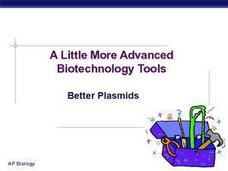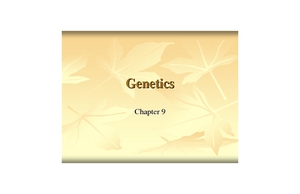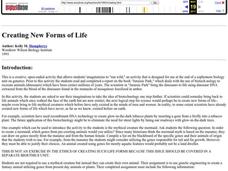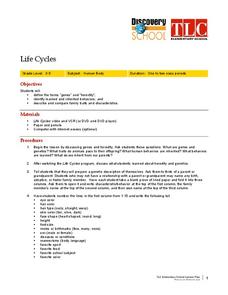National Geographic
Genetic Markers: Connecting the Dots
Biology buffs simulate how genetic markers are passed among populations in order to understand how these markers can help anthropologists map human migration. A couple of volunteers leave the room while you walk the remaining learners...
Howard Hughes Medical Institute
The Making of the Fittest: Evolving Switches, Evolving Bodies
How did the stickleback fish, which was once ocean bound, evolve to be able to persist in freshwater lakes? Hear from the scientists who identified the genes and related switches that allowed these survivors to adapt. In addition to the...
Curated OER
An Introduction to Nutrition
Whether you need a new textbook for your health class, or a few exercises and passages for your lesson on nutrition, you'll find what you need with a thorough nutritional science resource. With 15 chapters that cover elements of...
Howard Hughes Medical Institute
Explore Your Inner Animals
Human bodies prove evolution thanks to our genes, bones, and more. Learning about specific body parts and how they evolved from other species helps individuals better understand the transition species that helped us become who we are today.
Race Briges Studio
I am Indopino: Or, How to Answer the Question, "Who Are You?"
In our increasingly multi-ethnic society, many students find it difficult to identify themselves as belonging to any one ethnicity. Gene Tagaban, a Tlingit, Cherokee, Filipino offers his personal experiences with these questions in his...
Howard Hughes Medical Institute
Molecular Genetics of Color Mutations in Rock Pocket Mice
Can you identify mutations just by viewing DNA sequences? Scholars apply prior knowledge of DNA sequences to do just that in an engaging activity. They transcribe and translate genes, thus identifying the locations of mutations. Then,...
EngageNY
Identifying How Text Features Support Arguments: “The Exterminator"
Half and half. Split the class in half to gain a full understanding of sidebars. Pupils work in groups to discuss sidebars in text. Half of the groups read Seriously Sick, and the other half reads Killer Genes. They read using...
Curated OER
A Little More Advanced Biotechnology Tools: Better Plasmids
A nice set of information that will help your students understand the process of using recombinant plasmids. DNA hybridization and blotting mechanisms help illustrate expressed genes and the concepts behind the Human Genome Library....
Curated OER
Genetics
Students create a checklist of traits common in all of their families. Uisng a table, they compare and contrast their family members to non-family members. They also review dominant and recessive traits and discuss how knowing about...
Curated OER
Creating New Forms of Life
Although not particularly educational, here is a creative group activity in which high school biologists will use their imaginations to create a new life form combining characteristics from existing life forms. Each group must come up...
Curated OER
Who is the Sea Otter Related to?
Students examine the genetic relationships of different organisms. In groups, they discover the importance of genes and how different amino acids show various evolutionary relationships. They use an online database to continue their...
Curated OER
Genome Interactions
In this genome interactions worksheet, students read the passage about genome interactions then apply the knowledge to answer several short answer questions.
Curated OER
Genetic Technology
For this genetic technology worksheet, students will answer 6 true or false statements and 4 short answer questions based on the mapping and sequencing of the human genome and the applications of the Human Genome Project.
Curated OER
Huntington Disease
In this genetics worksheet, students access a website to read about what causes Huntington disease and how it is inherited. Then students complete 7 short answer questions.
Curated OER
Breeding Bunnies
Students learn the impact that genetics can have on the evolution of a population of organisms and become aware of the influence that the environment has onorganisms.
Curated OER
Punnett Squares
Fifth graders examine how traits are passed to their offspring using Punnett Squares. They demonstrate how a Punnett Square works by physically moving around boxes taped on the floor, representing the different traits of chicks and...
Curated OER
An Introduction to Genetics
In this genetic learning exercise, students will write their name and draw a picture of themselves. A genetic poem is included at the bottom of the learning exercise for students to read.
Curated OER
DNA Technology
In this DNA technology worksheet, students will review 12 vocabulary words relating to the uses and results of DNA technology in this crossword puzzle.
Curated OER
Heredity Worksheet #1
In this genetics worksheet, students review the experiments on pea plants that Mendel used to explain dominant and recessive alleles. This worksheet has 10 fill in the blank questions.
Curated OER
Nature And Nurture
Students develop an understanding of the role both nature and nurture play in determining an individual's traits. Using a website, students answer questions about nature and nurture in order to solve the riddle, What do you call a smart...
Curated OER
How Do Organisms Vary?
Students study variation of organisms. They determine this variation arises from genetic and environmental causes.
Curated OER
Life Cycles
Learners identify inherited traits. In this heredity lesson, students watch a video and construct a genetic description of themselves.
Curated OER
X or Y- Does it Make a Difference?
High schoolers examine the X and Y chromosomes. For this research lesson, students use the 5E lesson model as they read articles about human chromosomes then discuss their findings and opinions.
Curated OER
Incomplete Dominance
In this biology worksheet, students use the information given about genetics and Sponge Bob to complete each section of the sheet. They identify and explain incomplete dominance and use it to help them complete the questions that follow.
Other popular searches
- Dominant Genes
- Dominant and Recessive Genes
- Recessive Genes
- Genes and Heredity
- Chromosomes and Genes
- Genesis
- Dna, Genes & Chromosomes
- Dominate and Recessive Genes
- Traits and Genes
- Ethnicity Genes
- Color Genes
- Genes Alleles

























